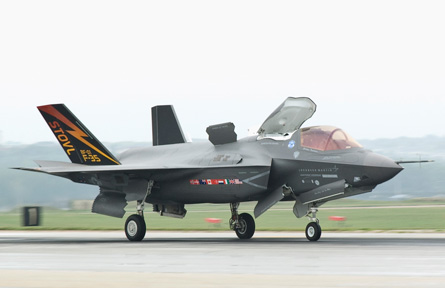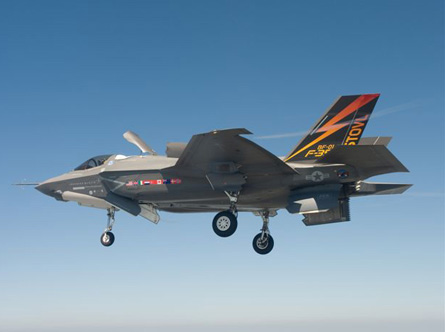Analysis and testing by Pratt & Whitney has validated a redesigned third-stage turbine blade for the Lockheed Martin F-35 Joint Strike Fighter's F135 powerplant. But first flight of the F-35B prototype in short take-off and vertical landing mode will be delayed by at least about three months, until the second quarter of next year.
Aircraft BF-1 first flew in conventional mode on 19 June, but has been grounded since August while P&W corrects a design flaw that has caused single blade failures in two STOVL engines since 2007.
 |
|---|
© Lockheed Martin |
Lockheed executive vice-president Ralph Heath confirmed on 20 November that P&W had "validated both through analysis and testing that this [redesign] is sound". The company is now scheduled to ship the first redesigned flight test engine to Lockheed two months late in January, Heath told a Wall Street investor conference.
BF-1 then will "go through a progressive build-up until we demonstrate the full viability of the STOVL aircraft", Heath said.
Lockheed says BF-1 may begin the build-up with check-out flight tests or go straight to the hover pit, where the engine will be run progressively to full power while the aircraft is anchored to the ground. The company will then begin a series of "fly and away" tests in conventional mode. Reconfiguring in-flight to a vertical landing will be achieved in increments through about June, when the first full STOVL mode test is now scheduled.
 |
|---|
© Lockheed Martin |
The new timetable puts funding approval for the next lot of STOVL low-rate initial production aircraft at risk of delay. Earlier this year, the Department of Defense required Lockheed to complete first flight of BF-1 before releasing funds for more F-35Bs. The DoD's leadership may change in January, but Heath says the same requirement could be used again.
The effect of the at least three-month delay of the STOVL mode test on the overall flight test programme is not clear. The US Marine Corps plans to launch the first F-35B operational unit in fiscal year 2012.
Meanwhile, Lockheed is preparing to increase production from one F-35 per month today to 11 per month in five years. "There is potential for DoD for advancing or increasing the ramp rate beginning lots 4 and 5 and beyond," Heath says. "We're actually prepared for that. We do have some capacity in the near-term. Even with the most aggressive ramp rates we're looking at they're still well below what we demonstrated 20-25 years ago with the F-16."
For more F-35 news and images, see Flight's aircraft profile
Source: Flight International























